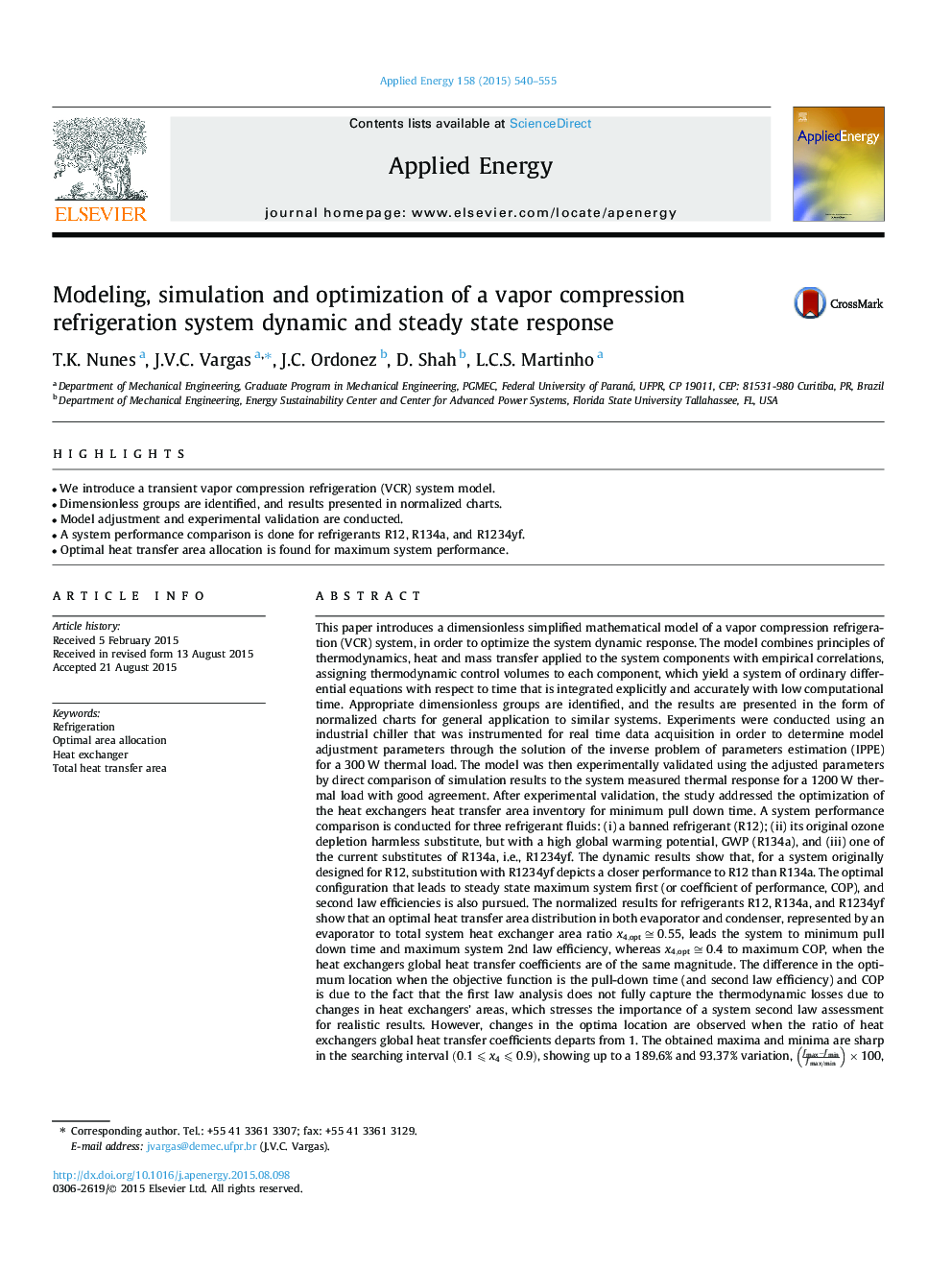| کد مقاله | کد نشریه | سال انتشار | مقاله انگلیسی | نسخه تمام متن |
|---|---|---|---|---|
| 6685791 | 501867 | 2015 | 16 صفحه PDF | دانلود رایگان |
عنوان انگلیسی مقاله ISI
Modeling, simulation and optimization of a vapor compression refrigeration system dynamic and steady state response
ترجمه فارسی عنوان
مدل سازی، شبیه سازی و بهینه سازی یک سیستم تبرید بخار فشرده سازی پویا و حالت پایدار
دانلود مقاله + سفارش ترجمه
دانلود مقاله ISI انگلیسی
رایگان برای ایرانیان
کلمات کلیدی
تبرید، تخصیص منطقه مطلوب، مبدل حرارتی، کل منطقه انتقال حرارت،
موضوعات مرتبط
مهندسی و علوم پایه
مهندسی انرژی
مهندسی انرژی و فناوری های برق
چکیده انگلیسی
This paper introduces a dimensionless simplified mathematical model of a vapor compression refrigeration (VCR) system, in order to optimize the system dynamic response. The model combines principles of thermodynamics, heat and mass transfer applied to the system components with empirical correlations, assigning thermodynamic control volumes to each component, which yield a system of ordinary differential equations with respect to time that is integrated explicitly and accurately with low computational time. Appropriate dimensionless groups are identified, and the results are presented in the form of normalized charts for general application to similar systems. Experiments were conducted using an industrial chiller that was instrumented for real time data acquisition in order to determine model adjustment parameters through the solution of the inverse problem of parameters estimation (IPPE) for a 300Â W thermal load. The model was then experimentally validated using the adjusted parameters by direct comparison of simulation results to the system measured thermal response for a 1200Â W thermal load with good agreement. After experimental validation, the study addressed the optimization of the heat exchangers heat transfer area inventory for minimum pull down time. A system performance comparison is conducted for three refrigerant fluids: (i) a banned refrigerant (R12); (ii) its original ozone depletion harmless substitute, but with a high global warming potential, GWP (R134a), and (iii) one of the current substitutes of R134a, i.e., R1234yf. The dynamic results show that, for a system originally designed for R12, substitution with R1234yf depicts a closer performance to R12 than R134a. The optimal configuration that leads to steady state maximum system first (or coefficient of performance, COP), and second law efficiencies is also pursued. The normalized results for refrigerants R12, R134a, and R1234yf show that an optimal heat transfer area distribution in both evaporator and condenser, represented by an evaporator to total system heat exchanger area ratio x4,optâ
0.55, leads the system to minimum pull down time and maximum system 2nd law efficiency, whereas x4,optâ
0.4 to maximum COP, when the heat exchangers global heat transfer coefficients are of the same magnitude. The difference in the optimum location when the objective function is the pull-down time (and second law efficiency) and COP is due to the fact that the first law analysis does not fully capture the thermodynamic losses due to changes in heat exchangers' areas, which stresses the importance of a system second law assessment for realistic results. However, changes in the optima location are observed when the ratio of heat exchangers global heat transfer coefficients departs from 1. The obtained maxima and minima are sharp in the searching interval (0.1⩽x4⩽0.9), showing up to a 189.6% and 93.37% variation, fmax-fminfmax/minÃ100, in which f is either the calculated system pull down time or second law efficiency, respectively, which was observed with refrigerant R1234yf, which points out their importance for actual HVAC-R (heating, ventilation, air conditioning and refrigeration) vapor compression systems design.
ناشر
Database: Elsevier - ScienceDirect (ساینس دایرکت)
Journal: Applied Energy - Volume 158, 15 November 2015, Pages 540-555
Journal: Applied Energy - Volume 158, 15 November 2015, Pages 540-555
نویسندگان
T.K. Nunes, J.V.C. Vargas, J.C. Ordonez, D. Shah, L.C.S. Martinho,
